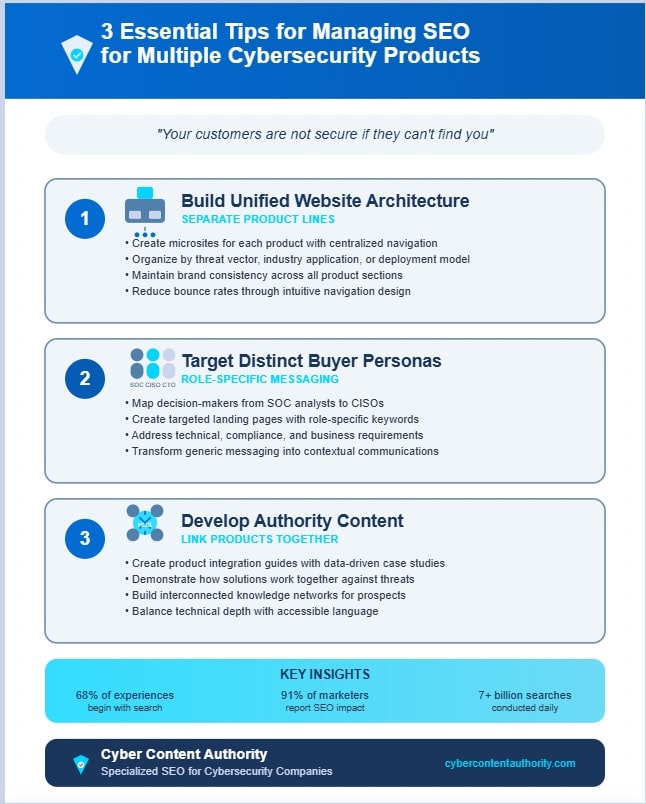Cybersecurity firms face distinct challenges when managing SEO for multiple cybersecurity products that conventional approaches fail to address effectively. In today’s threat landscape, where visibility determines market share, organizations must implement specialized strategies to differentiate their various security solutions while maintaining brand cohesion. The increasing complexity of search algorithms, coupled with the technical nature of cybersecurity offerings, necessitates a structured approach that balances product-specific optimization with overarching domain authority. These three essential techniques provide the framework security vendors need for managing SEO for multiple cybersecurity products.
Key Takeaways
- Create a unified website architecture with microsites for each product while maintaining centralized navigation and consistent branding.
- Develop intuitive product categorization by threat vector, industry application, or deployment model to enhance visitor engagement.
- Implement persona-targeted landing pages with role-specific keywords addressing the needs of diverse cybersecurity decision makers.
- Build authoritative content that demonstrates how your products work together to solve comprehensive security challenges.
- Balance technical depth with accessible language to engage both security specialists and non-technical stakeholders in purchasing decisions.
Build a Unified Website Architecture That Separates Product Lines

Crafting a robust and unified website architecture serves as the foundation for successful cybersecurity product marketing. This enables organizations to present complex security solutions in a comprehensible, navigable format while maintaining distinct product identities.
Effective product categorization requires establishing dedicated microsites or sections for each solution line. These can be connected through a centralized hub, which facilitates seamless navigation optimization without sacrificing brand consistency. Incorporating multi-factor authentication features within product demonstration areas significantly enhances visitor trust and showcases security best practices. Additionally, 68% of online experiences begin with a search engine, highlighting the importance of effective strategies for SEO for multiple cybersecurity products to drive traffic to these specialized sections.
In addition, implementing intuitive menus that delineate product offerings by threat vector, industry application, or deployment model guarantees visitors can efficiently locate relevant security solutions. This approach reduces bounce rates and increases engagement with technical specifications, case studies, and comparative analyses.
Target Distinct Buyer Personas for Each Security Solution
Successful cybersecurity product marketing extends beyond architectural considerations to incorporate precisely tailored messaging for the diverse stakeholders involved in security purchase decisions. Each stakeholder has distinct priorities, pain points, and evaluation criteria that must be acknowledged in SEO strategy.
Effective buyer persona segmentation requires detailed mapping of decision-makers—from operationally-focused SOC analysts to strategically-oriented CISOs—with content personalization strategies that align with their specific concerns. In particular, the Compliance Manager will respond to SEO content that demonstrates how security tools simplify compliance tasks through automated workflows and comprehensive reporting. Additionally, over 7 billion searches conducted on Google daily highlights the necessity of optimizing for visibility in a competitive landscape.
Success in cybersecurity marketing hinges on precise persona mapping that aligns content with each decision-maker’s unique operational or strategic priorities.
Organizations must develop targeted landing pages optimized with role-specific keywords while measuring engagement through persona-specific analytics.
When properly implemented, this segmented approach transforms generic security messaging into contextually relevant communications that address the technical, compliance, and business requirements unique to each stakeholder’s perspective.
Develop Authority Content That Links Your Products Together
Building authoritative content ecosystems catalyzes the integration of disparate cybersecurity products into cohesive solutions, thereby establishing the vendor as a trusted advisor rather than merely a point-solution provider.
Through strategic content syndication, organizations can demonstrate how multiple security offerings work in concert to address extensive threat landscapes, while emphasizing their technical expertise across domains. Additionally, 91% of marketers reported that SEO had a positive impact on their website performance, highlighting the importance of effective content strategies.
For maximum effectiveness, companies should develop product integration guides that illustrate, through data-driven case studies and expert interviews, the exponential security benefits achieved when deploying complementary solutions.
Additionally, cross-promotion between product-specific assets creates an interconnected knowledge network that guides prospects through the security ecosystem, reinforcing holistic messaging that addresses industry-specific pain points with unified, authoritative precision.
Creating content that balances technical jargon and accessibility helps engage both security specialists and other stakeholders involved in cybersecurity purchasing decisions.
Learn the Challenges of Managing SEO for Multiple Cybersecurity Products
Effective SEO for multiple cybersecurity products requires a strategic approach that balances unified architecture with specialized targeting. By implementing a coherent site structure, developing persona-specific content strategies, and creating authoritative resources that demonstrate product interconnectivity, organizations can establish market dominance while addressing the distinct needs of various security stakeholders. This all-encompassing framework transforms fragmented product marketing into a cohesive ecosystem that maximizes search visibility across the cybersecurity spectrum.

Frequently Asked Questions
How Do I Balance Keyword Cannibalization Between Similar Security Products?
Organizations must implement strategic keyword mapping across products while emphasizing content differentiation. Each security solution should target unique keyword clusters, highlighting distinctive features rather than competing for identical search terms.
Should I Create Separate Domains for Different Cybersecurity Product Lines?
Separate domains can enhance product differentiation when cybersecurity offerings target distinct markets. However, a unified domain strategy often delivers stronger brand cohesion and easier cross-product resource management for innovative security solutions.
How Often Should I Update Technical SEO for Cybersecurity Websites?
Cybersecurity websites require technical SEO audits monthly and thorough reviews quarterly. Website speed optimization should occur continuously, with immediate attention to critical issues that could impact security credibility or user experience.
What Metrics Best Measure SEO Success Across Multiple Security Products?
Effective metrics for multi-product SEO success include keyword performance across products, organic traffic growth, conversion rates per solution, and competitive visibility rankings that reveal market positioning opportunities within the cybersecurity landscape.
How Can I Leverage Competitor Backlinks for My Cybersecurity Offerings?
Companies can perform competitive research to identify valuable backlink sources, then conduct thorough backlink analysis to replicate competitors’ successful linking strategies while developing innovative content that attracts high-quality security industry links.



